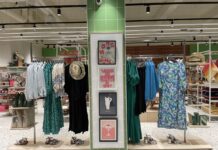Black Friday has undergone a significant transformation since its inception in 2010. First it was just about the discounts. Next it was about the instore experience, to get people out and shopping. Then, it was all about the online experience, with consumers hopping between online stores to find the best deals (and remaining stock).
Now, in the age of Covid, what will we see from the fourth wave of Black Friday – an amalgamation of these trends or a push into new frontiers thanks to constantly evolving technology?

We asked three experts to give their views on what Black Friday might hold this year, and how it might change the retail industry for good.
🏆
The 2024 Creative Retail Awards are open for entries.
The Creative Retail Awards are much more than a mere accolade; they represent the pinnacle of achievement in the retail industry. Garnering a nomination or winning one of these awards is a testament to innovation, excellence, and leadership.
www.creativeretailawards.com
Kevin O’Farrell, Associate Vice President, Analytic Partners:
“When Amazon first introduced Black Friday to the UK in 2010, it transformed festive shopping and successfully boosted the profits of many retailers. But while in the US, Black Friday remains primarily in-store, in the UK the fight for the best bargains has gone from the street to online; and Covid will only cement this for the future.
“But it is not as simple as brands switching their TV spend for social. Lockdown has dramatically altered the connected world we live in. It has accelerated digital adoption by 5 years, and with it, pulled into sharp focus the rise of “omnishopping”: researching, or experiencing the product in one channel, but converting in another. For example, looking at the past 12 months data, we can see offline channels play a major role in online traffic, and vice versa. For one brand, TV drove website traffic by 35% and PR by 11% compared to only 4% by social.
“To be successful in the fourth wave of Black Friday it’s not just about the deep price drop but pushing the message in the right channels during the buying frenzy. Brands and advertisers need to adapt, learn, and embrace omnichannel marketing. Not only to maximise effectiveness and RoI success, but to deliver the experience customers need today.”
Kam Phullar, Lead Strategist, Feed:
“Since storming onto UK streets in 2010, Black Friday has forced itself further into the mainstream conscience with every passing year. A decade on, Brits are expected to spend an estimated £7billion over the 2020 Black Friday weekend, though this year, shopping will be done almost entirely online. As brands attempt to differentiate themselves from their competitors, they’ll need to be thinking outside the box when it comes to the tech they lean on to increase conversion.
“Adopting AI and machine learning can help speed up the decision-making process by refining recommendations and predicting behaviours, which could even prevent consumers from losing interest and navigating away to a competitor’s site. Patience is scarce online, so seamless customer experience is essential, but this alone will not be enough. Brands must take the time to understand their consumers and offer solutions specific to their unique needs. With the vulnerable still encouraged to stay inside, it will be essential that sites are accessible to every customer.
“Innovative tech like AR will allow customers to ‘try before they buy’ and virtual shopping assistants will replicate an in-person customer experience for those less comfortable with digital spending. Brands must think smart and implement considered tech that solves a problem for their customer base, gimmicks simply won’t fly.”
Stuart O’Neill, Head of Creative, Tribal Worldwide London:
“This year, on Black Friday we will see a greater shift away from instore sales and towards e-commerce. However, some forward-thinking retailers are looking supplement physical retail with technology. A lot have introduced appointment booking and video conferencing as a means of face to face interaction within a physical retail space. We have even suggested the idea of customer-controlled telepresence robots in retail showrooms during lockdown for those who are desperate to feel like they are still walking around an environment to see that car, clothing item or kitchen.
“It’s interesting to see how retailers are trying to simulate the instore experience for consumers who are unwilling or unable to visit stores in person, but want more than the standard online experience. In the kitchen and home improvement industry, Virtual Reality is proving to be a really powerful reason to go back instore to experience their kitchen or space before committing to a purchase.
“In order to convince consumers to return to the high street, I think we will start to see retailers begin to adopt technology that offers customers a safer, connected, more tailored experience that starts online and then continues seamlessly instore.”















